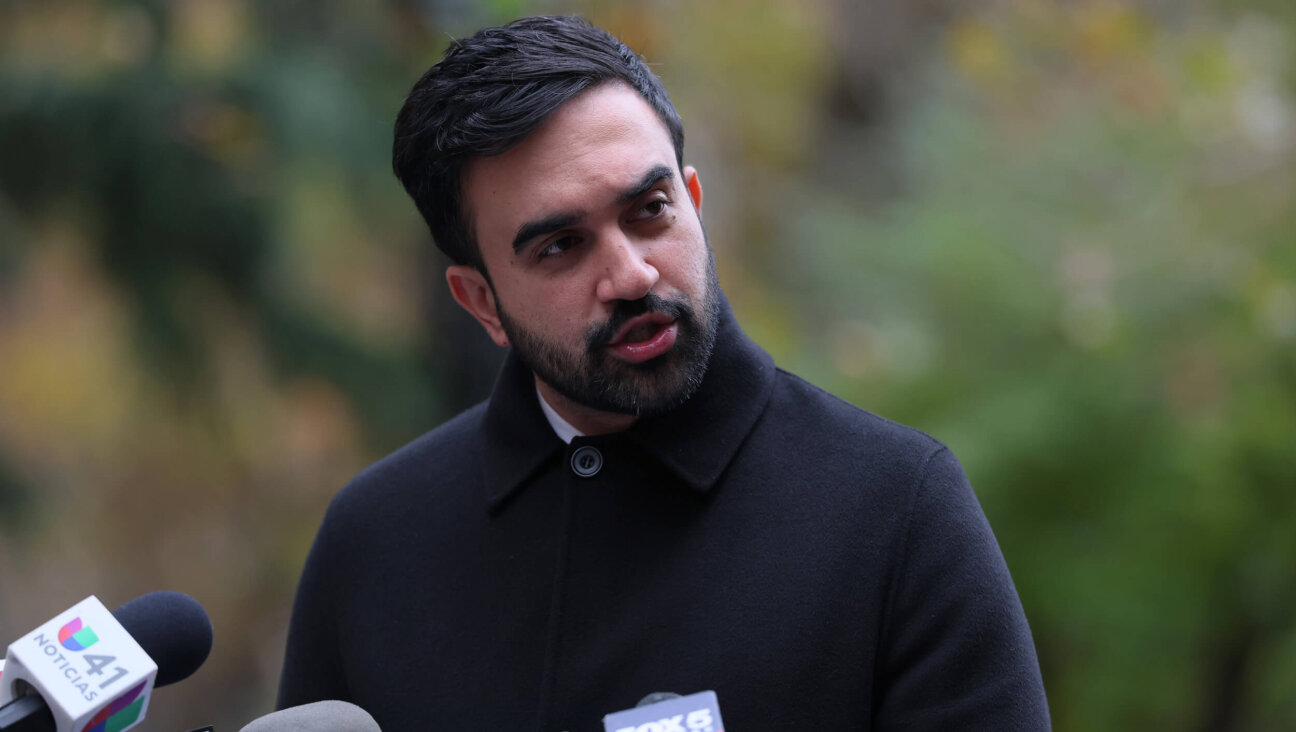One Giant Step for Israel as Company Plots Moon Launch

Over the Moon: Shimon Peres, Israel?s notoriously tech-happy president, greets teen space science whiz Amit Levin, who is part of a team trying to launch an Israeli space craft to the moon. Image by courtesy of spaceil
Is the startup nation poised to become the blast-off nation?
Past a gaggle of undergraduates and up two flights of stairs, in a shabby Tel Aviv University building, sits a team working to change the face of space travel — starting with an Israeli moon landing.
The group is designing a spacecraft that is just 3 feet tall and 300 pounds in weight and will be prepared to launch toward the lunar surface in 2015. The team hopes that the unmanned mission will set a precedent for space exploration with a tiny low-cost craft and pick up an international space prize.
The Google Lunar X Prize is offering $20 million to the first privately funded team to land a robot on the moon and have it send video, images and data back to Earth, as well as travel 500 meters over the lunar surface.
In a competition where many of the 25 entries are well-funded companies hoping that success will provide a commercial boost, the Tel Aviv-based team, SpaceIL, is the only not-for-profit.
It has a shoestring budget compared with its rivals — $30 million (all teams are expected to spend more than the prize money) — and relies on more than 100 volunteers to plan the craft and the mission alongside its staff of 13. But according to some scientists, they do seem to have a good shot.
“I think they have the know-how and most of the technology and have a very good chance of being successful and winning the competition,” said Aby Har-Even, former head of the Israel Space Agency.
SpaceIL’s entry is quintessentially Israeli — and not just because it is making the most out of limited resources. It has chutzpah, planning to “hitchhike” a tenth of the distance to the moon to save costs. It is heavily focused on promoting science education, even promising to donate the prize money to promote subjects like math and technology to young students. And it is driven by guts, not by experience; led by the young, and giving some key tasks to future scientists who are still in their teens.
“The time has come for an Israeli flag to be planted on the moon,” Israel’s president, Shimon Peres, an enthusiast for all things technological, told the Forward. “I am proud of the youngsters who created this initiative, to put the first Israeli spacecraft on the moon, and I know that they can achieve it.”
With all the costs of SpaceIL’s mission covered by individual and corporate donors, $20 million won will mean $20 million for science, technology, engineering and mathematics education in Israel. For months now, its staff, along with dozens of nontechnical volunteers, has been traveling to schools, getting children excited about the mission and about science in general.
“It’s working,” said co-founder and chief operating officer Kfir Damari, 30. “I finished one presentation, and a child asked for my autograph. Now, the fact that I can stand on a stage and say ‘I’m Kfir and I’m an engineer’ and get asked for my autograph is exactly the excitement I’m looking to create.”
From the physical surroundings it is difficult to believe that SpaceIL’s office is the hub of a space travel project. The place is so basic and low-tech that it doesn’t even have a properly functioning air conditioning unit: An old oscillating fan was brought from a closet to keep this reporter cool. But then you meet the brains.
Damari began studying computers in preschool and programming at the age of 6. He wrote his first computer virus at the age of 11. He and his two co-founders originally planned to make the spacecraft the size of a soda bottle, weighing just 11 pounds — and maintain that they still could manage this if it weren’t for the fact that you can’t buy tiny fuel tanks that are tested to a high enough standard.
“Small isn’t a problem,” he insisted. “In a small case you have a computer more powerful than Apollo,” he said, pointing to an iPhone. “Everything that you need to land a rocket on the moon is in here, even the battery.” So that it can also beam pictures, videos and data back to Earth, SpaceIL’s on-board computer will be the size of three smart phones.
For 15-year-old Amit Levin, it’s just another day at the office. A prodigy from a tiny village in the Sharon region, he is one of the key scientists locating a suitable landing site for the spacecraft — work that he undertakes between studying for his physics degree at Tel Aviv University and continuing his high school studies.
He began last year, with some other volunteers, analyzing NASA photographs of the lunar surface to look for landing spots after a SpaceIL scientist gave a recruitment talk at his university. “I was 14,” he recalled nostalgically, “and he was like a messiah to me.”
The shortlist for landing sites is getting narrower, and Levin works mostly alone, developing algorithms for further analysis of the surface.
“In school you work from an exercise book and the teacher has the answers, or the answers are in the back of the book and you’re not supposed to look,” Levin said. “This is the first time I’ve had a challenge and nobody knows the answer, which makes it so exciting.”
Compared to Levin, SpaceIL staffer Adam Green is an old man. At 24 he is in charge of planning the spacecraft’s route. He has never launched anything into space, but he has a master’s degree in aerospace engineering and says that he isn’t intimidated when consulting with top Israeli scientists, because most of them haven’t, either.
“As there’s no one in Israel with the experience of planning a mission to the moon, it’s not as daunting as it could be,” he commented. Green’s task is made even harder than a “simple” navigation to the moon by the fact that, to save costs, the Israeli craft will “hitchhike” 10% of its journey on a commercial satellite or spacecraft of a foreign space agency. Given that he won’t control the movement of the host satellite or craft, he doesn’t know exactly what his spacecraft’s starting point will be.
As GPS doesn’t work outside Earth’s orbit, the SpaceIL team had to find and create special navigation systems and orbit correction solutions to help Green. These include the Earth Moon Sensor, with a camera and photo processor that will take pictures of both Earth and the moon so that the spacecraft can position itself in relation to both. There are other homegrown Israeli inventions on board, including special “eyes,” a hazard-detection system developed with a Weizmann Institute expert on brain control processes.
The team is confident about most of the mission. “The only part that is really complicated and really new is the landing,” Damari said.
The spacecraft will hurtle toward the moon at 4,300 miles an hour. It will then use the main engine to slow down the approach — a process that will use half of the entire fuel supply. Parachutes don’t work close to the moon because there isn’t air to fill them up, so the plan is to slow the engines and stop them completely 30 feet above the surface of the moon and land via vertical free fall with the engine facing up.
SpaceIL is starting outreach activities in America. In April it showcased its prototype spacecraft at the Celebrate Israel Festival in Los Angeles and at the Israel Expo in Orange County, and it soon plans to recruit volunteers based in the United States to run workshops in Jewish schools.
“Just as many kids in Israel don’t feel connected to science, and we hope to change this, some Jewish kids abroad don’t feel connected to Israel,” he said. “This is cool enough to make them excited about Israel.”
Contact Nathan Jeffay at [email protected]
















